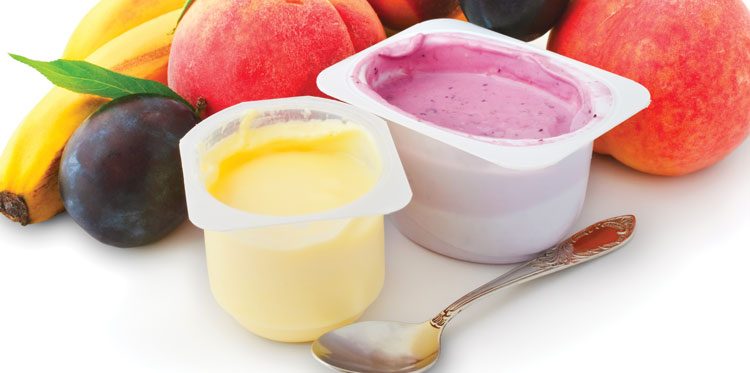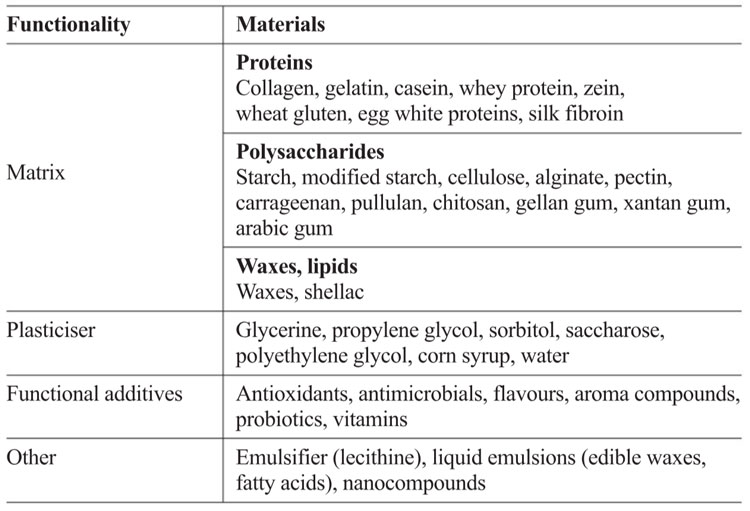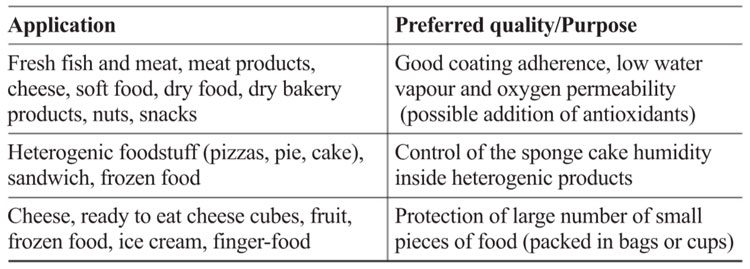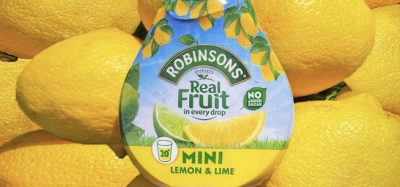Edible food coatings – just a trend or the future?
- Like
- Digg
- Del
- Tumblr
- VKontakte
- Buffer
- Love This
- Odnoklassniki
- Meneame
- Blogger
- Amazon
- Yahoo Mail
- Gmail
- AOL
- Newsvine
- HackerNews
- Evernote
- MySpace
- Mail.ru
- Viadeo
- Line
- Comments
- Yummly
- SMS
- Viber
- Telegram
- Subscribe
- Skype
- Facebook Messenger
- Kakao
- LiveJournal
- Yammer
- Edgar
- Fintel
- Mix
- Instapaper
- Copy Link
Posted: 9 April 2016 | Mario Ščetar, Mia Kurek | No comments yet
Why throw away the packaging? Let’s eat it! Food packaging development has undergone a research renaissance. Edible films and coatings that are directly consumed with the food are now in the service of modern food preservation systems, as a result of the lifestyle changes of consumers. The imagined scenario involves, for example, buying a yoghurt in a pot from a store (as usual); eating the contents (as usual); but then eating the packaging!


The question to consider is, why not pack and stay green? Considerable momentum has built over the last few years toward advances in food packaging technology; especially making packaging greener and better for the environment; minimising food and packaging waste; and making products healthier and safer.
An edible coating is defined as a thin layer of edible material, generally not exceeding 0.3mm, applied to the surface of foods in addition to or as a substitution for natural protective coatings. They are able to form a barrier against moisture, oxygen, UV-light and solute movement of the food1,2. The fact that it is edible is proof of its harmless nature. They must also be acceptable to consumers retaining the original taste, texture, and product appearance and not being detectable on the tongue. Edible coatings are generally classified according to their natural film forming material, i.e. polysaccharides, proteins, lipids and waxes, or a mixture of them. Minor components are also included in the formulations – essentially including plasticisers or acid based compounds3 (Table 1). Apart from, for example, traditional matrixes, i.e. chitosan, alginate, whey protein, etc.4-7, innovative edible polymers could also be applied. For example, researchers from Taft’s University developed water based silk fibroin suspension that enhances fruits’ shelf life at ambient room conditions by reducing cell respiration rate and water evaporation8.


Table 1: Examples of materials used for edible packaging
Packaging researchers are putting considerable efforts into making such edible packaging marketable. In the last five years we regularly witness flash news on edible wraps (Japanese Botan Rice Candy, with an edible clear rice-paper wrapper), edible food cups (Scoff-ee cup, KFC) and even water soluble soup bags (Monosol LLC). This packaging is considered as edible packaging as a whole.
There are numerous scientific studies that sum up different edible films used on all kinds of food products (Table 2). The main function is not full replacement of traditional packaging, but also providing further properties and adding benefits by functionality through natural additives used for food storage or its enrichment. Edible coatings can play a major role in the preservation of food products because they are considered to be a vehicle of functional compounds that are necessary to humans’ health and wellbeing. The most common are nutraceutics, phytochemicals (antioxidants and antimicrobials), flavours, bacteriocins and probiotics. In addition, coatings regulate moisture control and oil transport, mechanical and gas barrier properties of coated foodstuff. When the functional compounds are incorporated into the edible coating/film to perform their functions, they become a benefit for the food as well as the consumers.


Table 2: Applications of edible films
The incorporation of antimicrobial agents into edible coatings offers several advantages compared to traditional preservatives: the natural compounds can be applied directly on a food surface without penetrating the food matrix, thus acting precisely on a targeted place. Antimicrobial edible coatings allow the preservation of food quality by avoiding or reducing the growth of food spoilage pathogen microorganisms (Listeria moncytogenes, Salmonella and E. coli). For the selection of the appropriate antimicrobial agents, the backup on its activity on the targeted microorganisms is needed.
According to some industry analysis it is expected that edible coatings will drive the food packaging market during the forecasted period. The growing nutraceutical industry is also expected to be a driving factor for the edible films and coating market.
Currently there are a significant number of edible coatings available on the market – mainly for intact fruits and vegetables – and research continues with the objective of developing better coatings that are capable of preserving, or even improving, the quality of intact and minimally-processed fruits and vegetables during storage9. According to the Food & Agriculture Organization of the United Nations (FAO), 50% of global crops are lost through the food supply chain. When used for preservation of meat, poultry, and fish, edible coatings serve as barriers to moisture migration, and limit diffusion of gases such as O2 or CO2 that are important in food deterioration10. Positive results are also seen for dairy products, particularly cheese, where coatings may potentially improve ripening control; prevent organoleptic and quality changes (e.g., texture, flavour, and aroma losses); extend shelf life by constraining mass transfer and permeability to gases; and improving the nutritional value of cheese, thus contributing to a balanced diet11. Customers’ awareness of the importance of a healthy diet is prompting the latest research trends in the area that consider ways to lower the oil content of fried food. Frying induces several product characteristics including appearance, aroma, flavour and texture (crispness); however, the quantity of oil in fried food increases after frying. The underlying problem is that some fried products may contain up to 50% fat of the total product weight. Edible coatings reduce the oil content of deep-fat-fried foods, acting either as a lipid barrier in the form of thin films when added in dry form, or by their gelation properties during heating12 preventing water loss at the same time12,13.
Meanwhile, a good attempt to increase the storability of food focuses on the combination of preservation techniques that include edible coatings. These technologies fulfil the consumer trend to buy fresh fruits while assuring food safety and prolonging shelf life. A combination of gamma irradiation with gamma rays and a commercial edible coating improved the postharvest quality of tamarillo fruits14. A combination of pulsed light, alginate coating and malic acid dipping treatments actively reduced Listeria innocua counts in fresh-cut mango15.
The latest development is an edible coating that can empty every last drop of sticky liquids. Recently, The Colorado State University researchers developed a superhydrophobic coating – a nanoscopic surface layer that repels water. This developed coating is classified as an edible coating as it is made from carnauba wax and beeswax – two natural FDA-approved edible materials16.
Considering the increasingly frequent occurrence of allergic reactions in people – particularly to individual components – the coatings applied to food need to be properly declared.
Such materials in any case should not have a negative impact on human health and must be approved by the official institutions for food safety and materials in contact with food, such as the European Food Safety Authority (EFSA).
It is expected that edible packaging will be more present in the future. Consumers are willing to accept environmentally friendly materials and biodegradable options instead of the traditional plastics that are currently used. The traditional way of packaging in bags and boxes will still be required for health and transport reasons, but will not need as much packaging as in the past, which can reduce costs and waste.
The advantages of this kind of packaging are truly enormous – from increased nutritional values to the environmental and economic benefits. It is ultimately consumers that will decide whether it remains a trend of the early 21st century, or really becomes the future of packaging.
About the authors
Mia Kurek, PhD, currently works as Scientific and Teaching Assistant at the University of Zagreb, in the field of Food Packaging. Her main points of interests are bio-based packaging materials, mass transfers and food shelf-life. She worked as PhD candidate at the University of Burgundy and as postdoctoral fellow at INRA Montpellier.
Mario Ščetar, PhD, is currently employed as Assistant Professor of Food Packaging at Faculty of Food Technology and Biotechnology, University of Zagreb. His main research interests are new packaging materials for nonthermal processing of food and shelf-life prolongation.
References
- Guilbert, S.; Gontard, N.; Gorris, L.G.M. Prolongation of the shelf-life of perishable food products using biodegradable films and coatings. LWT—Food Science and Technology 1996, 29, 10–17
- McHugh, T.H.; Senesi, E. Apple wraps: A novel method to improve the quality and extend the shelf life of fresh-cut apples. Journal of Food Science 2000, 65, 480–485
- Falguera, V., Quintero, J. P., Jimenez, A., Munoz, J. A., and Ibarz, A. 2011. Edible films and Coatings: Structures, active functions and trends in their use. Trends in Food Science & Technology, 22, 292–303
- Tharanathan, R. N. 2003. Biodegradable films and composite coatings: Past, present and future. Trends in Food Science & Technology, 14(3), 71–78
- Kokoszka, S., and Lenart, A. 2007. Edible coatings—formation, characteristics and use—A review. Polish Journal of Food and Nutrition Sciences, 57(4), 399–404
- Rojas-Grau, M. A., Soliva-Fortuny, R., and Martin-Belloso, O. 2009. Edible coatings to incorporate active ingredients to fresh-cut fruits: A review. Trends in Food Science & Technology, 20(10), 438–447
- Embuscado M.E., Huber, C.E. 2009 Edible films and coatings for food application, Springer, NY
- Marelli, B., Brenckle, M.A., Kaplan, D.L., Omenetto, F.G. 2016 Silk Fibroin as Edible Coating for Perishable Food Preservation. Scientific reports 6, article number 25263
- Olivas, G.I, Dávila-Aviña, J.E, Salas-Salazar, N.A , Molina, F.J 2008 Use of edible coatings to preserve the quality of fruits and vegetables during storage, Stewart Postharvest Review 2008, 3:6
- Nunes, E.M., Silva, A.I., Vieira, C.B., Souza Filho, M., Silva, E.M., Souza, B.W., 2016, Edible Coatings and Films for Meat, Poultry, and Fish. In: Edible Food Packaging, Cerqueira, M.A.P.R., Pereira, R.N.C., Ramos, O.L.S., Teixeira, J.A.C., Vicente, A.A. (Eds.). CRC Press, pp. 413-429
- Silva Ramos, O.L., Pereira, R.N.C., Martins, J.T., Malcata, F.X. Edible Packaging for Dairy Products, In: Edible Food Packaging, Cerqueira, M.A.P.R., Pereira, R.N.C., Ramos, O.L.S., Teixeira, J.A.C., Vicente, A.A. (Eds.). CRC Press, pp. 383-412
- Kulp, K. Batters and breadings in Food processing, 1990. American Association of Cereal Chemists
- Mellema, M. 2003. Mechanism and reduction of fat uptake in deep-fat fried foods. Trends in food science and technology 14, 364-373
- Abad, J., Valencia-Chamorro, S., Castro, A., Vasco, V. 2016 Study of the effect of the combination of two nonconventional treatments, gamma irradiation and the application of an edible coating, on the postharvest quality of tamarillo (Solanum betaceum Cav.) fruits, Food Control, dx.doi.org/10.1016/j.foodcont.2016.05.024
- Salinas-Roca, B., Soliva-Fortuny, R., Welti-Chanes, J., Martín-Belloso, O. 2016, Combined effect of pulsed light, edible coating and malic acid dipping to improve fresh-cut mango safety and quality, Food Control, 66, 190-197
- Wang, W., Lockwood, K., Boyd, L.M., Davidson, M.D., Movafaghi, S., Vahabi, H., Khetani, S.R., Kota, A.K. 2016 Superhydrophobic coatings with edible materials, ACS Applied Materials & Interfaces 8 (29), 18664-18668.







